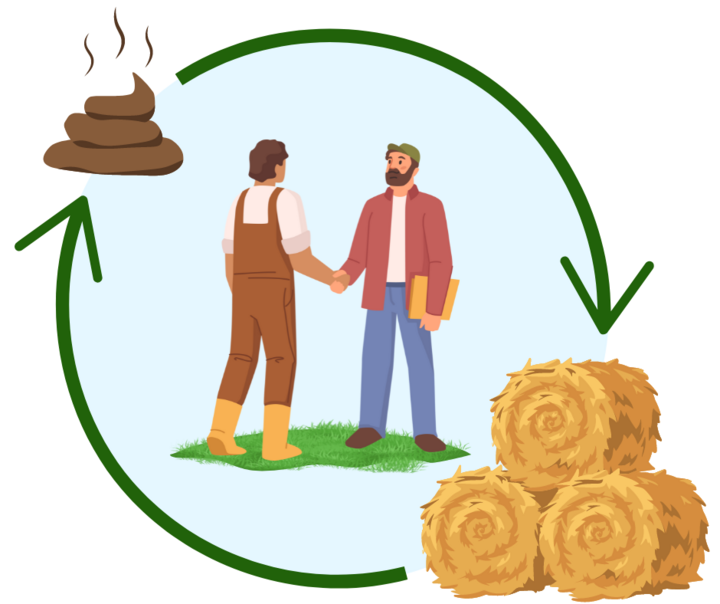Trading manure and crop residues, considerations for a fair trade
Listen to a discussion of the content in this article on this episode of the BeefWatch podcast. You can subscribe to new episodes in iTunes or paste http://feeds.feedburner.com/unlbeefwatch into your podcast app. |
With harvest around the corner, you might be considering trading manure for cornstalks or vice versa. In many ways, it’s easier to pay cash for either product, but there are advantages to trading. This article will focus on what kinds of things to consider to be sure any deal made is a fair trade.
One of the most common crop residues harvested in Nebraska is cornstalks so that’s the example in this article, but the following is true for any residue including soybean stubble and wheat straw.
Determine the value of both products

The easiest part of making sure any trade is fair is to make sure that the cash value of both products is similar. To do that:
- Take a sample of the products to be traded and have them analyzed for their nutrient content.
- Calculate the useful fertilizer equivalents of both the manure and the crop residue. Note that if a field has sufficient nutrient levels for the next crop, the useful fertilizer equivalent of that nutrient would be zero. For instance, if the field will not need potassium, the potassium would not have any fertilizer value in either product. Once you value your manure from a fertilizer perspective, you can do the same thing with the crop residues. Learn how to calculate the value of manure and value your cornstalk bales.
Available Manure Nutrient Content (lbs/ton) | Manure Nutrient Value ($/ton) | Bale Nutrient Content (lbs/ton) | Bale Nutrient Value ($/ton) | |
|---|---|---|---|---|
| Nitrogen (N) | 7.7 | $6.50 | 17 | $14.25 |
| Phosphorus (P2O5) | 13.1 | $11.50 | 4 | $3.50 |
| Potassium (K2O) | 17.6 | $12.00 | 37 | $25.50 |
| Sulfur (S) | 1.9 | $1.25 | 3 | $1.75 |
| Total |
| $30.25 |
| $45.00 |
Factor in harvest, transportation and application costs
Along with fertilizer value, consider who is paying for harvest costs for the residues, application costs for the manure, and transportation costs for both products. This will be different for each situation, but for this example, the crop farmer is paying a custom harvester to bale the cornstalks and the livestock producer is using their own equipment to haul and apply the manure as well as transporting the bales back to the livestock operation.
In this case, because the harvest costs are being incurred by the person that is bartering the bales, the cost of baling should be added to the value of the bales. Assuming the fertilizer value of one 1200 pound bale was $27 and, using a near average custom rate, baling costs $18.25 per bale, then the value per bale for trading should equal $45.25.
To compare, if the fertilizer value per ton of manure is $30.25 per ton and application costs equal $3.25 per ton, then the value should be $33.50 per ton. However, the livestock producer is incurring the cost of hauling the cornstalk bales back to the livestock operation, so the livestock producer needs to factor that in as well.
| Value to Farmer | Value to Livestock Producer | |||
|---|---|---|---|---|
| Fertilizer value per bale (assumes 1200 lb bale) | $27.00 | Fertilizer value of manure per ton | $30.25 | |
| Raking cost per bale (assuming 2.5 bales per acre) | $2.75 | Cost of manure transportation and application per ton | $3.25 | |
| Baling cost per bale | $15.50 |
| ||
| Total value per bale | $45.25 | $33.50 | ||
| Cost of transporting cornstalk bales back to operation per bale | -$2.50 | |||
In this scenario, a fair trade (dollar for dollar) would be about 5 tons of manure for every 4 bales (1.25 tons of manure per bale or 0.8 bales per ton of manure) where:

Dollars and cents don’t tell the whole story
Like everything in farming, the decision to trade manure for crop residues is more complicated than it initially seems. When considering a trade, the livestock producer might be considering the following:
- available labor for manure hauling and hauling bales,
- proximity of the bales to the operation to decrease time and transport of getting those bales to their operation,
- feed value of the bales, or
- the necessity of feed source. When feed sources are limited, the livestock may weigh the value of the crop residue higher.
On the other hand, the crop farmer might be considering:
- the loss of the residue which can impact erosion potential and snow capture over the winter, which can be particularly important on non-irrigated fields and in drought years,
- the value of micronutrients in the manure that can decrease additional commercial fertilizer costs if a field is deficient,
- disease mitigation if growing the same crop the following year, or
- the impacts of removing organic matter on soil health.
So, if you're considering trading crop residue bales for manure or vice versa, make sure the dollars and cents pencil out. Then weigh the intrinsic and logistical costs of the trade. Trading may seem like it should be a simple decision, but there are many factors that weigh into that decision.
This article was reviewed by Jenny Rees and Ben Beckman.